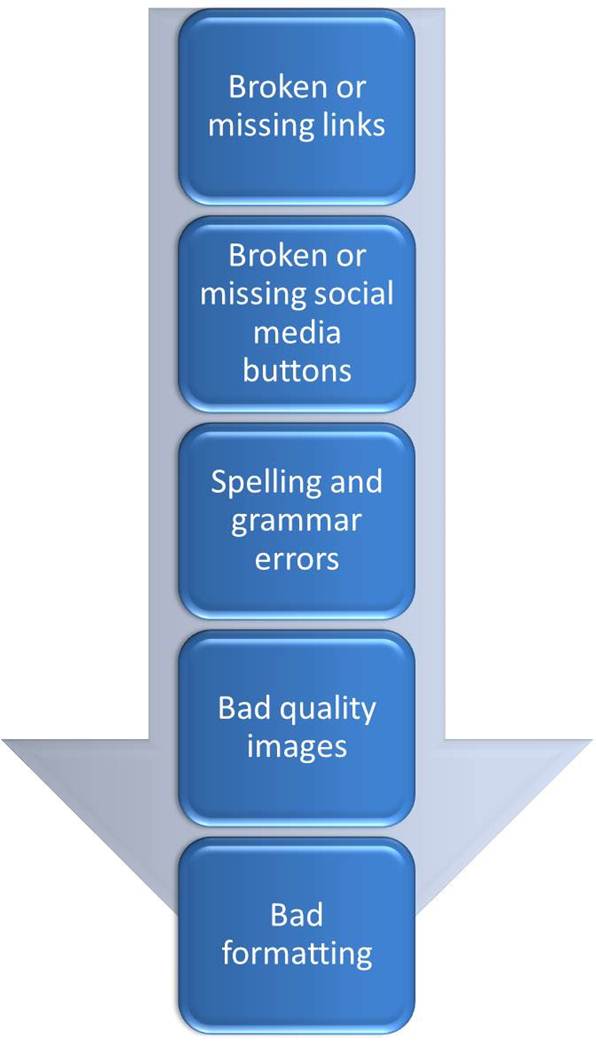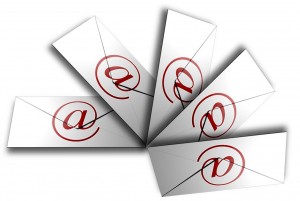Entries Tagged 'newsletter' ↓
June 1st, 2012 — copywriting tips, email marketing, Essential tools for small businesses, marketing, newsletter
Email marketing and newsletter marketing are great.
They allow you to quickly contact thousands of customers in one go.
But the speed can sometimes be the downfall of many marketers, because once they’ve hit send, their message is out there – mistakes and all.

But that’s just the tip of the ice berg.
More seriously, they could easily fall foul of the CAN-SPAM Act, which provides the rules and regulations that have to be abided by for those undertaking commercial emailing and provides recipients of emails the right to make you stop sending them.
When undertaking email marketing, all your messages have to comply with the Act:
- You must not use misleading, deceptive or false information in your “To”, “From”, “Reply to”, subject line etc. You must specify whether the email is from a company or individual and the subject line must reflect the content of the email.
- Your physical postal address must be supplied on all emails.
- You must include an opt-out link and deal with every request promptly.
- Use a legitimate email service provider.
Always check before hitting send
We are all human so, occasionally, things go wrong.
But continuously sending out emails and newsletters that contain numerous errors is just sloppy.
Don’t forget that your company’s reputation is built on your correspondence with your customers, whether through emails, newsletters, web content, brochures etc. Therefore, it is essential you make sure you have thorough checking procedures in place.
Should the worse happen and something slips through the net, apologise and make it up to your customers. Never act in haste, because that could compound the problem.
Email marketing is a highly valuable tool for any business. But it’s essential it’s done well. Make sure your emails comply with the regulations set out in the CAN-SPAM Act and their content is thoroughly checked before hitting send.
May 28th, 2012 — copywriting tips, email copywriting, email marketing, Essential tools for small businesses, marketing, newsletter
Email marketing and newsletters are the most cost effective methods to reach thousands of people quickly.
Using your own home grown marketing list, it enables you to get great information and offers out to your targeted market.
But how can you be sure you’re making the most of this marketing opportunity?
Well, as you would expect, the content of your emails is crucial to your strategies success.
Here are 5 tips to make sure you get the most from each of your emails.
1. Length
No one wants War and Peace landing in their inbox.
Everyone is time-limited these days, so you must ensure that what you send is short, concise and to the point.
On average, about 400 – 600 words is plenty, any more than that and people will start to switch off.
2. Relevant
It’s important to tie the content in with what’s happening at the current time. Make sure you give spring offers in the spring etc. With the Jubilee on its way, create a newsletter around that. If you have a local event happening, try to incorporate that to boost resonance with your readers.
3. Get to the point
No one wants to read paragraph upon paragraph of waffle.
Make your point in the first paragraph so your reader knows the aim if of your newsletter. Also, make sure you include other sub headings so people can see at a glance what your newsletter covers. That way they can pick out the information they need without having to wade through everything.
4. Links
Introducing links to your text is a great way to a) shorten your emails/newsletters and b) drive more traffic to your website.
These are especially useful if you want to add a lengthy article to your newsletter. You can add an intriguing snippet and then link out to the rest of the article so the reader can click through to it at their convenience.
5. Be human
There’s nothing worse than receiving a boring, corporate newsletter. If you send out something like that, you’ll bore your readers rigid.
Inject some personality and be human. Write it in the second person and be chatty. You’ll find people are more likely to read something that’s friendly that something overly corporate.
If you’re still uncertain about how to structure your emails and what content to add, take a look at the emails you subscribe to and that you read.
What makes them stand out?
Why do you read them?
If you can capture the essence of those that make you stop and read them you’re half way there.
September 5th, 2011 — copywriting tips, newsletter, proofreading
 Writing a monthly newsletter is a great way to keep in touch with your customers and add value to your relationship.
Writing a monthly newsletter is a great way to keep in touch with your customers and add value to your relationship.
You can use them to share information, give tips and offers.
But generating great content on a regular basis can seem like a daunting task. But it doesn’t have to be. All you need is:
- A great looking template
- A simple process to write content-rich material that can be repeated again and again
The template you use should reflect your business image. Something in line with your website’s design would be ideal. Just make sure it’s a clean, unfussy design that won’t detract from the information it contains.
But what about the simple process I mentioned? Well, below is an example to show how easy it can be to write your newsletter when you have a system in place.
Newsletter writing process
This 5 step writing process is a great way to kick start the creative process every month. The number of topics you pick will determine the length of your newsletter.
- Choose 3 topics for the main body of your newsletter
- Choose 3 topics for your side bar
- Interview industry experts or research a specific topic
- Write and edit your articles
- Proofread your newsletter
1. Main topics
These articles will make up the body of your newsletter. You can choose as many topics as you like, but the more you have, the longer your newsletter will be.
They don’t have to be long articles (approximately 300 – 500 words) and can cover things that have happened in the news (or your industry) recently, what’s happening now and what’s coming up.
2. Side bar
The side bar is for quick bits of news so they’re not as in depth as the main topics you’ll write about.
It also gives you the opportunity to add regular pieces such as a book of the month, announcement of forthcoming events, tips, and offers.
3. Interviews and research
Conducting an interview or writing a research-based article can add real meat to your newsletter.
The interview would act like a magazine Q&A session. In it, you could get an expert’s insight into a particular hot topic that your readers are interested in.
The same can work for the research article. Find out what’s important to your readers and write about it. But make sure you include links to the external articles you used for your research so they can read around the subject if they want to.
4. The writing process
This is the part many people dread. But writing well rounded, interesting articles is easy.
Make sure you write in the second person (i.e. ‘you’) to instantly build rapport with your readers. As mentioned above, use hypertext links to direct your reader to more information. This will add value to them and show you really do understand your subject.
Another important feature within your newsletter is your call to action. It could be a link back to your website, an instruction to email for more information or a competition. If you want to make your newsletter marketing a two-way street, you must ask your reader to do something.
Of course, they can only get in touch if you include your contact details. Never hide away from your customers. As with your website copy, make sure your postal, email and phone details are easily available otherwise it looks as though you have something to hide.
The final part of the writing process involves leaving your newsletter alone. Put it to one side for a few days before reviewing the content to make sure it provides the messages you wanted.
5. Proofread
This is the final and most important part of the process.
The last thing you want to do is hit send only to find a glaring typo.
Putting the newsletter aside for a few days before reviewing it will help with the proofreading process. Ideally, you should get someone else to proof it for you. But, if that isn’t possible, giving yourself a few days grace before checking it through should help you spot any mistakes before you send it out.
Over to you
Done well, a regular newsletter can help build and cement relationships with your customers. By adding value and maintaining regular contact, your newsletter can encourage sales.
Do you send out a monthly newsletter?
Have you found it beneficial?
Do you have a process you follow each month like this one? Please leave a comment below and share your newsletter experiences with us.
August 3rd, 2011 — copywriting tips, email marketing, newsletter
You all know how great newsletters are. But do you really know how to write newsletters effectively?
They provide a way for you to keep in regular contact with your customers.
But what do you put in them?
Keeping your subscribers engaged and interested in your monthly mailings is essential. But how do you achieve that?
Timely
To ensure your content resonates with your reader, try to tie it in with topical events or seasonal subjects.
So in the summer months don’t start talking about Christmas!
By making your content relevant to what’s going on around you, you are showing your readers that you are a company that thinks – you’re not just emailing them to get them to buy. You will be providing timely and useful information.
Solving problems
Your newsletter shouldn’t just be about selling.
Adding an article that talks about ‘how to’ achieve something, how to solve a problem or one that offers general advice about something your readers are interested in, will add value to your relationship with them.
By offering this type of information they are more likely to remain subscribed to your newsletter. Plus talking about your field in this way will position you as an expert. So when they need help – guess who they’ll turn to?
Short and sweet
How long should your newsletter be?
It’s best to keep it short – no more than 400 words or so. That way you’ll keep your readers attention right to the end.
Send them something that goes on for eternity and they’ll delete it because they won’t have time to read it.
But it’s not only the length of your newsletter than should be short. By keeping your sentences and paragraphs short too, you’ll make it easier to read.
And of course, don’t forget your strong headline. If that, and the first couple of sentences don’t grab their attention, you would have lost them.
Link
OK, so you’re keeping your newsletters short but this month you want to talk about something in more detail because you feel it’s particularly important to your readers.
That’s where linking comes in; write a short piece outlining the main issues and then link out to more information. This could be a blog post or article you have written or an external news story.
This technique keeps your newsletter short and sweet and still provides your readers with the information they need.
Have fun
Your newsletter also has to be enjoyable to read.
That will not only come down to its content but also how it’s written.
Be human with your writing; conversational copy is far more readable than formal, staid language. Inject a bit of humour if you can and keep it light. Above all, let your personality shine through.
Newsletters are an amazing tool. They enable you to keep in regular contact with your customers and enhance that relationship by offering news, tips and offers.
Do you send out a regular newsletter? If so why not leave a comment below and tell us how you use it. You might have more tips for us all to follow.
May 18th, 2011 — copywriting tips, email marketing, newsletter, search engine optimisation, seo, website copywriting
 Is yours one of the many businesses out there that sends regular newsletters to your customers?
Is yours one of the many businesses out there that sends regular newsletters to your customers?
You probably spend hours slaving over the content (or get a copywriter to slave away for you) to ensure your message is spot on, you’re offering your readers great information and, of course, the odd offer to encourage them to buy from you.
So what happens once it’s been sent?
If you just broadcast it, forget it and then move on to the next month’s issue you’re missing a HUGE opportunity.
Shall I tell you why?
Using your newsletters to boost your SEO
Let me tell you something about your newsletters.
You already have a strong subject line/header, your content will be SEO friendly (stands to reason as you’re writing about your company, products and services) and it’s original content.
So why not breathe life into your newsletter once it’s been sent rather than forgetting about it?
Placing it within your website will help your SEO no end because you’ll be feeding the Google Monster fresh, original content each and every month – yum.
Of course, you can’t just cut and paste the content into your website; you’ll need to make a few amendments such as:
- Create a new page for each newsletter, so you’ll be treating them like articles.
- Use links within the text (hyperlinks using your keywords) to point to other relevant information within your site or other articles.
- Remove any mentioned of forthcoming events etc. Unlike your newsletter which is transient, your new web page will be around for a long time to come.
- Take out any special offers for subscribers.
- Play around with the layout to make sure it looks attractive. Add sub headings, images and even video to enhance your message.
By repurposing the content in this way you’ll add volume to your website, boost your SEO and offer your readers some great information.


 Writing a monthly newsletter is a great way to keep in touch with your customers and add value to your relationship.
Writing a monthly newsletter is a great way to keep in touch with your customers and add value to your relationship. Is yours one of the many businesses out there that sends regular newsletters to your customers?
Is yours one of the many businesses out there that sends regular newsletters to your customers?




